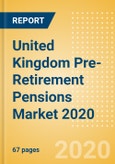Summary
The total UK pensions market grew 16.1% to £16.4bn annual premium equivalent (APE) in 2019. Workplace pensions drove growth as minimum pension contributions increased to 8%. Direct benefit to direct contribution transfers continue as companies de-risk and individuals take advantage of pension freedoms. COVID-19 will bring uncertainty to saving for retirement. The UK economy has officially entered into recession and disposable incomes are set to fall as unemployment rises. This will force many individuals to temporarily stop making pension contributions as they cut non-essential spending. The UK pensions market is projected to contract at the start of the forecast period before returning to growth.
This report examines how the pensions market is changing as consumers are encouraged to save in personal pensions while state pension funding is under pressure. It discusses the impact of auto-enrollment on saving, as well as other regulatory changes. The report explores consumers’ attitudes towards planning for retirement, examines how engaged they are with their pensions, and identifies how they access financial advice on their investments. It also discusses how consumer awareness around pensions can improve with technological developments.
The report provides current and historical data on the size of the market by product type - covering individual pensions, workplace pensions, and trust-based pensions - and distribution channel. The size of the pensions market has been forecast to 2024.
Scope
- A notable 16.7% of individuals do not know how much their pension is worth. Of those who do, over half stated that their main pension pot is worth less than £30,000.
- Women have considerably smaller pension pots than men and their state pension is lower.
- 30.1% do not register to use their pension provider’s website, while a further 12.5% have registered but never used it.
Reasons to Buy
- Examine the size of the pensions market.
- Learn about recent market developments and upcoming regulatory changes.
- Discover how consumers are saving towards retirement.
- Understand consumer engagement with their pensions.
- Learn about the impact of COVID-19 on pensions.
Table of Contents
Companies Mentioned (Partial List)
A selection of companies mentioned in this report includes, but is not limited to:
- Aviva
- Prudential
- Lloyds Banking Group
- Phoenix Group Holdings
- Zurich Financial Services
- BlackRock
- Fidelity
- LV=
- Quilter
- Rothesay Life
- Royal London
- Pension Insurance Corporation (PIC)
- Just Group
- Canada Life
- Threadneedle Pensions
- Aegon
- PensionBee
- Yolt
- Starling Bank
- Lumio
- Money Dashboard








